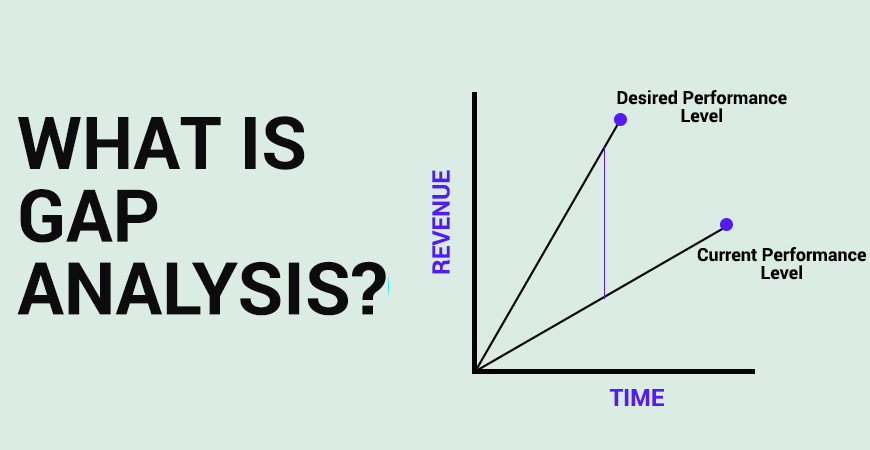
WHAT IS GAP ANALYSIS?
Introduction to Gap Analysis:
A gap analysis is an examination of your current performance for the aim of distinctive variations between your current state of business and wherever you’d wish to be. Gap analysis involves the comparison of actual performance with potential or desired performance. Gap analysis identifies gaps between the optimized allocation and integration of the inputs (resources), and therefore the current allocation-level. This could reveal areas that may be improved. Gap analysis involves determinative, documenting, and up the distinction between business necessities and current capabilities. Gap analysis naturally flows from benchmarking and from alternative assessments. Once the overall expectation of performance in associate business is known, it’s potential to check that expectation with the company’s current level of performance.
It can be boiled down into a few questions:
Where are we now?
Where do we wish we were?
How are we going to close the gap?
Gap analysis can be conducted on:
System: Features that exist in the system now versus the features that need to exist in the future
System interface: Data that a system provides to an interface now versus data that will need to be provided in the future
Business process: The steps and activities of a current business process versus the steps and activities of the business process in the future.
Business goals and metrics: How well a business meets certain goals and metrics now versus the targeted goals and metrics at some point in the future.
Types of Gap:
There are four types of Gap:
- Performance Gap: The difference between expected performance and the current performance.
- Product/Market Gap: The gap between budgeted sales and actual sales is termed as product/market gap.
- Profit Gap: The variance between a targeted profit and actual profit of the company.
- Manpower Gap: When there is a lag between required number and quality of workforce and actual strength in the organization, it is known as manpower gap.
For different types of gaps, various types of strategies are used by the firm to get over it.
3 Steps for Gap Analysis:
1. Analyze your current state
You first need to discover where your organization currently is and where you would like to be. Start with your current state. Your analysis can include qualitative information, such as team processes/methodologies, and quantitative information, such as the number of sales calls made each week. In fact, your gap analysis process should evaluate everything you currently do, then you will get the “actual picture.”
2. Identify the ideal future state
Once you have a figured out the actual picture, understand how your team or organization currently functions, you need to become strategically idealistic. Where would you want to be? But most important is, what needs to happen to get to your expected performance?
Maybe you have an exceptional marketing team that outsources all its content; maybe your goal is bringing that creative process back in house to meet your brand guidelines. Perhaps you realize you want to create a cultural shift to better match your product or services.
3. Bridge that gap
This is the most important part. You have to identify why and what gaps exist and how they are blocking you from reaching your goal. The better part is figuring out how to overcome the difficulties. Invent clear objectives that will help you in your transition. An advantage of Gap analysis is that it helps project managers come up with tactical ways of improving output to meet expected targets by helping to predict market conditions. It can be used to measure various gaps in a business.
There are 2 major viewpoints of Gap Analysis:
Inter-rater gap analysis: This is the most common use of gap analysis. It compares data from the participant with that from the other rater groups, such as the favourite boss, staff, peers, and customers. Just about every 360-degree assessment software program allows you to do this. Both single- and dual-scale assessments provide this type of gap analysis.
Intra-gap analysis: This type of gap analysis identifies specific differences within each rater group, such as differences within the staff or peer or customer rater groups. That is, participants (the people being assessed by the individual raters) can identify the number of staff or customers who have identified their performance as a strength or an area for development. Participants quickly realize that not all of the raters in a particular group have the same expectations regarding their performance. Raters are not identified by name.
Gap Analysis Template
4 Steps To Completion
1. Identify the current state of your department.
First, identify the priority of that plan or scorecard. For example, your banking organization wants to increase growth by 30% a year and has been growing at 8% per year. That puts your “current state” at 8% growth. Or, perhaps you work for a manufacturing organization that is producing revenue of $180,000 per employee, and your goal is to grow that to $250,000 per employee. That would put your current state at $180,000 per employee.
Keep in mind, your current state doesn’t have to be financial. If your nonprofit currently serves 10,000 meals a week to the homeless, that is your current state. Or, if you work for a municipal government, you might have 200 public safety incidents per 100,000 citizens per year—another example of current state.
2. Identify where you want to be with your department.
This future goal is sometimes called a desired state, future target, future state or stretch goal. In order to accomplish this, you will want to think about how you are doing today in your current state and where you really want to be within a reasonable time frame. If you are doing a gap analysis within the context of your strategic plan, take a look at the targets on your plan. These targets may be 3-5 years out, which is ideal. Where are you with them? To athat, know that, go back to your current state areas of focus.
3. Identify the gaps in your department.
Now that you’ve recognized where your organization is currently and where you want it to be in the future, it’s time to bridge the gap.
Take a look at the chart above; the “gap” is the gray shaded area, which demonstrates the difference between where you are and where you want to be. When identifying gaps in your department, you need to ensure that your goal and your current state exist in the same time period. So if your future goal is three years out, you need to extrapolate your current state out for three years to see the appropriate gap. For example, if you are growing at 8% and you want to be growing at 30% a year for three years, you will want to consider how much revenue you have currently and how much you’ll have in 3 years at your current pace. If you currently have $100 in revenue, you would be at almost $220 with 30% growth in three years, and $126 with 8% growth in the same time period. So your gap is $94.
This is a great time to figure out why there is a gap.
- Be specific about the gap. If your revenue per employee is $70,000 less than what you planned, why is that? Is there some issue with the working style, with your customers, or with your costs?
- Determine why this gap has occurred. Do this until the root causes of the gap become clear. For example:
- Why are customers so difficult to work with?
Because they want something custom. - Why do they want custom work?
Because they are dealing with a different problem than our which we didn’t realize. - Why didn’t we imagine the problem the customer is facing? Because we started out in the healthcare industry and now most of our customers are in the banking industry.
- Why haven’t we built a product for the banking industry?
Because our product development team is not thinking about new product offerings. - Why aren’t we thinking about new product offerings?
Because we are too busy building custom products.
- Why are customers so difficult to work with?
4. Devise improvements to close the gaps in your department.
Now that you’ve discovered why the gap in your department is taking place, it’s time to figure out the proper course of action to close it. Use the following guidelines to ensure the improvements you come up with are solid:
- Base all improvements on the information you discovered while identifying the gaps. If your team is too busy doing custom work, it will be difficult for them to step back and devise a new product offering. Perhaps if you stop taking on custom work for a few weeks, that will free up your team to create a product for your new target clients.
- Consider the cost of implementation for each solution. Perhaps you don’t have the capability to stop working with your current customers. Can you outsource the development of a new offering? Maybe partner with another organization?
- Identify end dates when you’d like to have the gaps resolved. Without setting an end date for improving the customer experience, it may end up being overlooked or ignored. Set a completion date, even if it is years in the future and then set a target or vision to ensure success.
Pick a Business Analysis training course to learn more about Gap Analysis and other Business Analysis concepts



